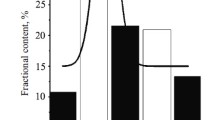Abstract
The problems of using hollow ceramic microspheres based on smoke emissions generated by power plants to obtain syntact materials with increased dielectric characteristics are considered. Comparative dielectric properties of the materials considered and materials based on hollow glass microspheres are described.
Similar content being viewed by others
REFERENCES
V. Yu. Chukhlanov and É. P. Sysoev, “Application of hollow microspheres in organosilicon syntact foam plastics,” Steklo Keram., No. 2, 11–12 (2000).
V. Yu. Chukhlanov and A. N. Alekseenko, “Application of syntact foam plastics with organosilicon binders in construction,” Stroit. Mater., No. 6, 26–27 (2001).
V. Yu. Chukhlanov and V. V. Kireev, “Dielectric characteristics of syntact foam plastics with a polyorganosiloxane binder in the range of super-high radio frequencies,” Plastich. Massy, No. 4, 25–27 (2003).
Author information
Authors and Affiliations
Rights and permissions
About this article
Cite this article
Chukhlanov, V.Y., Sysoev, É.P. Dielectric Characteristics of Syntact Materials Based on Hollow Ceramic Microspheres with Organosilicon Binders. Glass and Ceramics 61, 190–191 (2004). https://doi.org/10.1023/B:GLAC.0000043090.07100.67
Issue Date:
DOI: https://doi.org/10.1023/B:GLAC.0000043090.07100.67




